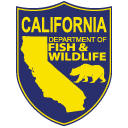
photo by S. Harris, USFWS
As a surfer in northern California, I get to enjoy spectacular views of the California coastline. In between waves, there are times when I look around in awe at the scenery – geometric rock outcroppings, softened by endless treetops, further improved by chance sightings of curious wildlife. Of all the beautiful spots in northern California, one of my favorites is special to more creatures than just surfers – Castle Rock Special Closure.

CDFW Marine Region map
Castle Rock (or Castle Island as it reads on some maps) resides half a mile offshore in the turbid waters of the Pacific Ocean. The 14-acre isle can be seen from the quaint town of Crescent City near the Oregon border. It is a seasonal home and valuable pit stop for many animals, providing refuge along the migratory route for several species of sea birds and marine mammals. Examples include common murres, which arrive annually by the tens of thousands to raise chicks, and endangered Steller sea lions which make frequent visits to the island to rest. The island was adopted as a National Wildlife Refuge in 1979, and included as part of the California Coastal National Monument in 2000. The most recent addition of special closure status to the waters surrounding Castle Rock in 2012, and its management as part of the state’s network of marine protected areas (MPAs), further highlights the important habitat it protects.

photo by F. Sharpe, NPS
Castle Rock and the surrounding area have been used by the Tolowa Dee-ni’ Nation over thousands of years for sustenance, including the gathering of seabird eggs and the hunting of seals from 30- to 40-foot redwood dugout canoes. The turn of the 20th century saw the island as a destination for specialty egg collectors (called oologists) and grazing sheep. Interest in protecting Castle Rock was reignited in the mid-1970s when the Aleutian cackling goose, once on its way to extinction, was observed using the island as a seasonal roosting site.

USFWS photo
Since that time, many studies have highlighted Castle Rock’s unique significance. Surveys have shown that the island hosts more than 100,000 breeding seabirds representing 11 species – the second largest seabird breeding site in California behind Southeast Farallon Island off the coast of San Francisco. This attribute contributed to the creation of Castle Rock Special Closure in December, 2012. The special closure restricts anyone from entering the waters around Castle Rock from the island’s shoreline to 300 feet offshore. The multiple layers of protection for Castle Rock and its surrounding waters – National Wildlife Refuge, National Monument, and now Special Closure – ensures that birds and other marine wildlife have a sanctuary protected from human disturbance.

USFWS photo
Although you can experience California’s MPAs in a myriad of ways, Castle Rock Special Closure is one of those places best enjoyed from a distance – preferably from the top of a surfboard! Believe it or not, you can also experience Castle Rock Special Closure from the comfort of your own home. The U.S. Fish and Wildlife Service, Redwood National and State Parks, and Humboldt State University operate a live streaming camera on the island from April through August. You are bound to see a common murre or two, or even glimpse a Steller sea lion. Discover for yourself what makes Castle Rock Special Closure so… special!

photo courtesy USFWS, RNSP, HSU
Castle Rock Special Closure is one of the 14 special closures in California’s statewide MPA Network. Please visit CDFW’s MPA website for more information, and sign up to receive updates about the MPA Management Program.
post by Leandra Lopez, CDFW Scientific Aid
Learn more about MPAs by diving into the Exploring California’s Marine Protected Areas series!


